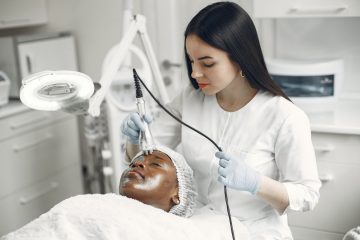Welcome to the comprehensive guide to radio-frequency skin tightening sessions! If you’re looking to revive your skin and achieve amazing results, you’ve come to the right place. In this article, we’ll explore the world of radio-frequency skin tightening and delve into the incredible benefits it offers.
How does radio-frequency skin tightening work?
Radio-frequency skin tightening is a non-invasive procedure that uses innovative technology to stimulate collagen production and tighten loose, sagging areas of the skin. The procedure involves the application of controlled heat to the skin, which penetrates deep into the dermis. This heat stimulates the production of new collagen fibers, which helps to tighten and firm the skin.
During the radio-frequency skin tightening session, a handheld device is used to deliver the controlled heat to the target areas of the skin. The device emits radio-frequency waves that generate heat in the underlying layers of the skin, without causing any damage to the surface. This heat stimulates the fibroblast cells in the dermis, which are responsible for producing collagen. As a result, the skin becomes tighter, firmer, and more youthful-looking.
The heat from the radio-frequency waves also helps to improve blood circulation and lymphatic drainage in the treated areas. This can further enhance the overall appearance of the skin by reducing puffiness and promoting a healthy, radiant complexion.

Benefits of radio-frequency skin tightening
Radio-frequency skin tightening offers a wide range of benefits for those looking to rejuvenate their skin. One of the key advantages of this procedure is its non-invasive nature. Unlike surgical options, radio-frequency skin tightening does not require incisions or anesthesia, making it a safe and comfortable option for many individuals.
Another major benefit of radio-frequency is its ability to stimulate collagen production. Collagen is a protein that provides structure and elasticity to the skin. However, as we age, our collagen production decreases, leading to sagging and wrinkles. By stimulating collagen production, radio-frequency skin tightening helps to improve skin elasticity, reduce the appearance of fine lines and wrinkles, and restore a more youthful appearance.
In addition to tightening and firming the skin, radio-frequency can also improve the texture and tone of the skin. The heat generated during the procedure helps to promote cell turnover and collagen remodeling, resulting in smoother, more even skin.
Who can benefit from radio-frequency skin tightening?
Radio-frequency is suitable for a wide range of individuals who are looking to improve the appearance of their skin. It can be particularly beneficial for those who are experiencing signs of aging, such as sagging skin, fine lines, and wrinkles.
This procedure is also a great option for individuals who have lost a significant amount of weight and are left with loose, excess skin. Radio-frequency skin tightening can help to tighten and tone the skin, providing a more contoured and sculpted appearance.
Furthermore, radio-frequency skin tightening can be used on various areas of the body, including the face, neck, abdomen, arms, and thighs. Whether you’re looking to tighten loose skin on your face or want to improve the appearance of your stomach after pregnancy, radio-frequency skin tightening can be tailored to meet your specific needs.

What to expect during a radio-frequency skin tightening session
Before undergoing a radio-frequency session, it’s important to have a consultation with a reputable provider. During this consultation, your provider will assess your skin and discuss your goals and expectations. They will also explain the procedure in detail and answer any questions or concerns you may have.
On the day of your session, you will be asked to remove any jewelry or accessories that may interfere with the procedure. Your provider will then cleanse your skin and apply a gel or conductive lotion to the treatment area. This gel helps to enhance the conductivity of the radio-frequency waves, ensuring optimal results.
Once the gel is applied, your provider will use a handheld device to deliver the radio-frequency waves to the target areas of your skin. You may experience a warm or tingling sensation during the procedure, but it should not be painful. If you do feel any discomfort, be sure to communicate with your provider, who can adjust the settings accordingly.
The duration of a radio-frequency skin tightening session can vary depending on the size and number of areas being treated. Generally, a session can last anywhere from 30 minutes to an hour. Upon completion of the treatment, resume daily activities immediately, as no downtime is associated with the procedure.
Results you can expect from radio-frequency skin tightening
After a radio-frequency skin tightening session, you can expect to see immediate improvements in the appearance of your skin. The treated areas will appear tighter, firmer, and more lifted. However, the full benefits of the procedure will continue to develop over time as collagen production is stimulated.
For most individuals, a series of radio-frequency skin tightening sessions is recommended to achieve optimal results. Typically, a course of 4 to 6 treatments, spaced 2 to 4 weeks apart, is advised. This allows for consistent collagen stimulation and gradual skin tightening.
It’s important to note that individual results may vary, as everyone’s skin is unique. Factors such as age, skin condition, and lifestyle habits can influence the outcome of the procedure. However, many individuals report significant improvements in the appearance of their skin, with a reduction in wrinkles, improved skin texture, and a more youthful complexion.
Before and aftercare tips for radio-frequency skin tightening
To ensure the best possible results from your radio-frequency skin tightening sessions, it’s important to follow some before and aftercare tips. Before your session, it’s recommended to avoid excessive sun exposure, as well as any tanning beds or self-tanning products. This helps to minimize the risk of skin damage and ensures the radio-frequency waves can penetrate the skin effectively.
It’s also advisable to avoid any harsh skincare products or treatments, such as chemical peels or microdermabrasion, in the days leading up to your session. These treatments can make the skin more sensitive and may increase the risk of discomfort during the procedure.
After your radio-frequency skin tightening session, it’s important to keep your skin hydrated and protected. Use a gentle, hydrating moisturizer to nourish the skin and apply sunscreen with at least SPF 30 to protect against harmful UV rays. It’s also recommended to avoid any strenuous exercise or activities that may cause excessive sweating for 24 to 48 hours after the procedure.
Comparing radio-frequency skin tightening to other skin tightening methods
Radio-frequency is just one of the many options available for skin tightening and rejuvenation. Other popular methods include laser treatments, ultrasound therapy, and surgical procedures such as facelifts. Consider each method’s advantages; the best choice depends on your unique needs and goals.

One major advantage of radio-frequency is its non-invasive nature. Unlike surgical procedures, there is no need for incisions or anesthesia, which reduces the risk of complications and downtime. Radio-frequency skin tightening is also generally more affordable than surgical options, making it a more accessible choice for many individuals.
Another advantage of radio-frequency is its versatility. It can be used on various areas of the body, including delicate areas such as the neck and under the eyes. This makes it a great option for those looking to address multiple concerns or target specific areas of concern.
However, it’s important to note that radio-frequency skin tightening may not provide the same dramatic results as surgical procedures. While it can significantly improve the appearance of the skin, it may not be able to achieve the same level of lift and tightening as a facelift, for example. For individuals with severe skin laxity, a surgical option may be more suitable.
Finding a reputable provider for radio-frequency skin tightening
When considering radio-frequency skin tightening, it’s crucial to find a reputable provider with experience and expertise in the procedure. Look for providers who are licensed or certified in aesthetic treatments and have a track record of successful outcomes.
Start by researching providers in your area and reading reviews from previous clients. Consultations are also a great opportunity to assess the provider’s knowledge, professionalism, and communication skills. During the consultation, don’t hesitate to ask questions about the provider’s experience, the equipment they use, and the expected results.
Ensure the facility meets safety and hygiene standards before the procedure. Cleanliness, proper equipment maintenance, and adherence to infection control protocols are all important factors to consider.
Conclusion
Radio-frequency is a powerful tool for achieving tighter, firmer, and more youthful-looking skin. By stimulating collagen production and improving skin elasticity, this non-invasive procedure can address signs of aging, reduce wrinkles, and enhance overall skin tone and texture.
If you’re looking to revive your skin and achieve amazing results, radio-frequency skin tightening may be the solution for you. Consult with a reputable provider, discuss your goals and expectations, and embark on a journey towards rejuvenated skin. With the science behind radio-frequency skin tightening on your side, you can confidently take steps towards a more youthful, radiant complexion.
So, what are you waiting for? Discover the incredible benefits of radio-frequency skin tightening and unlock the potential for skin transformation today!
